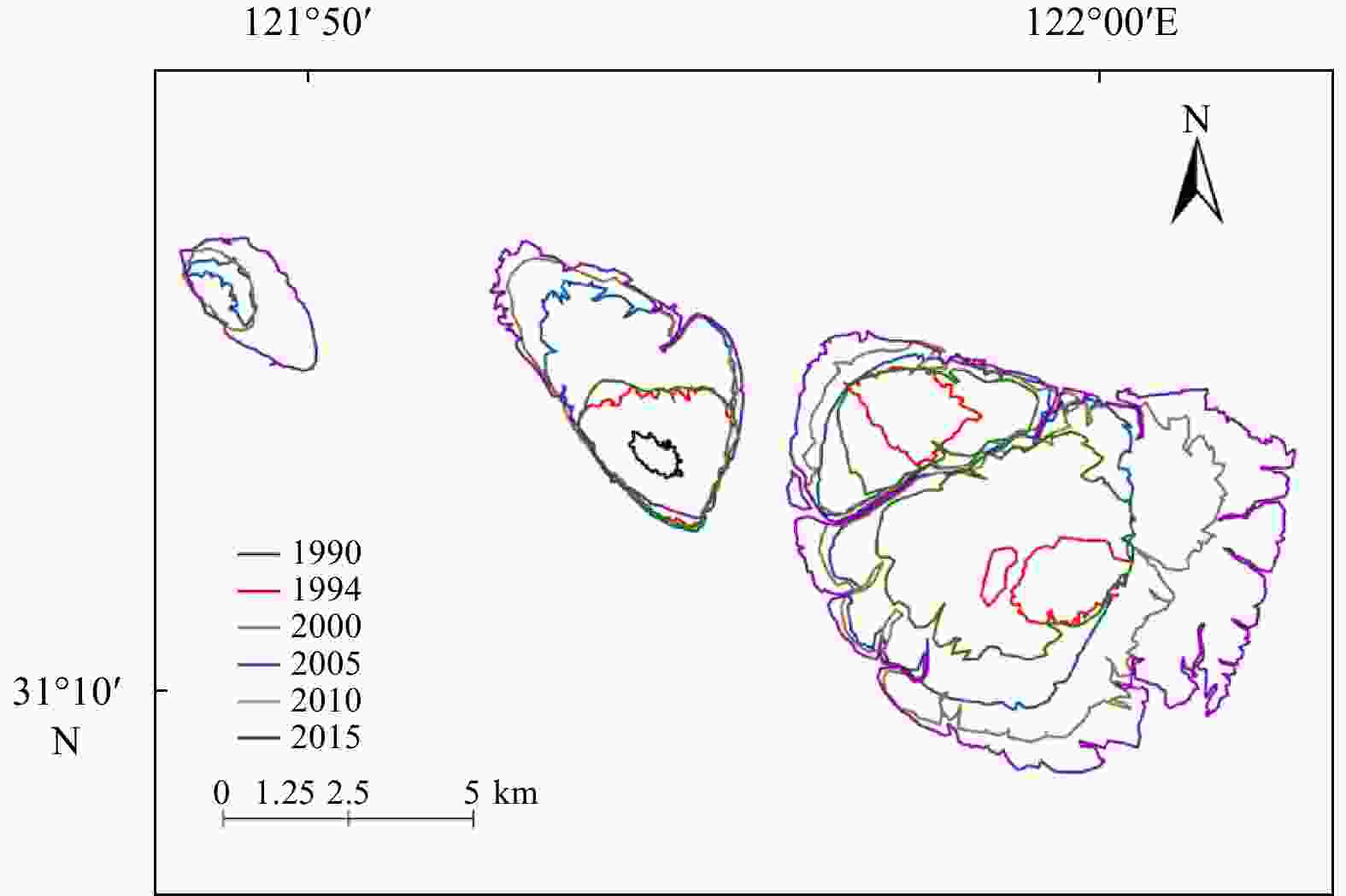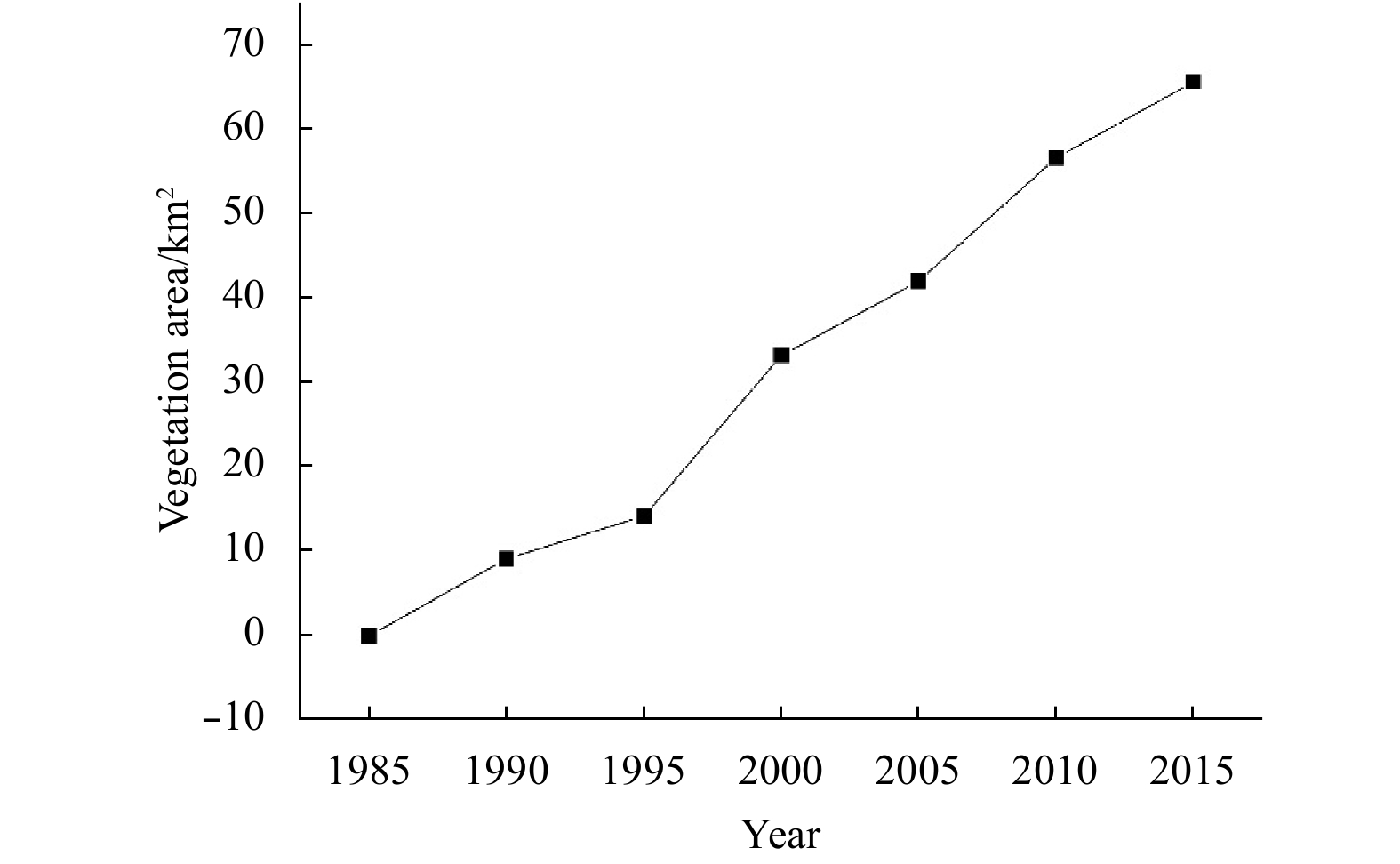Evolution of shoals and vegetation of Jiuduansha in the Changjiang River Estuary of China in the last 30 years
-
Abstract: The evolution of the shoals and vegetation plays an important role in maintaining the stability of the river regime and the estuarine ecosystem. However, the interaction between the evolution of shoals and vegetation dynamic has rarely been reported. In this study, we determined the interaction between the shoal and vegetation evolution of Jiuduansha in the Changjiang River Estuary in the last 30 years. We did this through the collection and summarization of the existing data of the regional hydrological processes, wading engineering, and vegetation, and combined it with the analysis of nautical charts and remote sensing images. During the past 30 years, the expansion of the shoals within the 0 m isobath in Jiuduansha was obvious, with an increase of 176.5%, while the expansion of the shoals within the 5 m isobath was relatively slow. The regional hydrological characteristics in the Jiuduansha area changed dramatically, especially the sediment discharges. The area of vegetation in Jiuduansha increased from 9.1 km2 in 1990 to 65.68 km2 in 2015, while the variations in the different vegetation types were different. The best combination of environmental factors with a significant correlation on the shoals within the 0 m isobath is the area of Spartina alterniflora and Phragmites australis. The evolution of Jiuduansha shoals was significantly affected by the variations in hydrological characteristics. Meanwhile, on a long-term scale, the expansion of the shoals could promote the regional vegetation expansions due to the suitable elevation and environmental conditions it provides. The interaction between the shoal and vegetation evolution varied in the different vegetation types and different elevations. In the future, long-term monitoring and detailed data are needed to the systematical analysis of the interaction between the hydrological processes and the evolution of the shoal and vegetation.
-
Key words:
- Jiuduansha shoals /
- Changjiang River Estuary /
- vegetation /
- evolution
-
Table 1. Wading engineering and variations in the hydrological characteristics in the area of Jiuduansha in the past 30 years
Year Wading
engineeringSpilt ratio of water/% Spilt ratio of sediments/% Sediment concentration
/kg·m–3Average flooding tide current velocity/m·s–1 Average ebbing tide current velocity/m·s–1 South Passage North Passage South Passage North Passage South Passage North Passage South Passage North Passage South Passage North Passage 1985 – 47.2
(1984)1)52.8
(1984)1)44.6
(1984)1)55.4
(1984)1)1.8845
(1982)6)2.8255
(1982)6)0.84
(1983)7)0.83
(1983)7)1.06
(1983)7)1.22
(1983)7)1990 – 46.3
(1988)2)53.7
(1988)2)46.9
(1988)2)53.1
(1988)2)– – – – – – 1995 Deep Waterway Project (Phase I, II)10), Nanhui Dongtan Reclamation Project11) 47.6
(1995)1)52.4
(1995)1)54.3
(1995)1)45.7
(1995)1)– – – – – – 2000 42.8
(2000)3)57.2
(2000)3)47.0
(2000)3)53.0
(2000)3)2.089
(2000.8)5)1.282
(2000.8)5)0.63
(2002.8)8)0.83
(2002.8)8)1.29
(2002.8)8)1.25
(2002.8)8)2005 52.2
(2005)3)47.8
(2005)3)52.8
(2005)3)47.2
(2005)3)1.121
(2005.8)5)0.394
(2005.8)5)1.26
(2005.8)8)0.63
(2005.8)8)1.41
(2005.8)8)1.19
(2005.8)8)2010 Deep Waterway Project (Phase III)10) 59.19
(2010)4)40.81
(2010)4)61.1
(2010)4)39.7
(2010)4)0.647
(2010.8)5)0.501
(2010.8)5)0.98
(2010.8)8)0.75
(2010.8)8)1.57
(2010.8)8)1.34
(2010.8)8)2015 58.4
(2015)4)41.6
(2015)4)61.8
(2015)4)39.2
(2015)4)0.666
(2013.8)6)0.727
(2013.8)6)– 0.78
(2014.9)9)– 1.19
(2014.9)9)Note: – represents no data was found in that period. Data source: 1) Feng, 2010; 2) Xie et al., 2014; 3) Liu et al., 2008; 4) Yang et al., 2018; 5) Liu et al., 2017; 6) Yao et al., 2015; 7) Chen, 2003; 8) Lin et al., 2015; 9) Wang, 2016; 10) Wei et al., 2016; 11) Li et al., 2016. Table 2. Variations in the area of the different vegetation types in Jiuduansha during 1987–2015
19871) 19911) 19971) 20021) 20061) 20081) 2013 Phragmites australis 0 1.81 3.78 8.11 16.04 17.96 20.10 Spartina alterniflora 0 0 1.09 7.39 18.68 22.34 33.81 Scirpus mariqueter 6.91 9.26 13.40 18.83 15.90 16.71 8.75 Note: Data source: 1) Liu et al., 2009. Table 3. Correlations between the area of the shoals, vegetation and the annual runoff, sediment discharge
M0 M5 RF SED VA SA PA SCA SCA 0.386 0.620 –0.343 –0.240 0.379 0.143 0.361 1.000 PA 0.989** 0.902** –0.266 –0.986** 0.982** 0.969** 1.000 SA 0.961** 0.820* –0.164 –0.983** 0.962** 1.000 VA 0.992** 0.917** –0.164 –0.965 1.000 SED 0.981** 0.868** 0.226 1.000 RF –0.236 –0.112 1.000 M5 0.921** 1.000 M0 1.000 Note: M0 represents the area of the shoals within the 0 m isobath, M5 the area of the shoals within the 5 m isobath, RF river runoff, SED sediment discharge, VA the total area of the vegetation, SA the area of Spartina alterniflora, PA the area of Phragmites australis, and SCA the area of Scirpus mariqueter. * A significant correlation between the factors; ** an extreme correlation between the factors. Table 4. Significance of correlations between the area of Jiuduansha shoals and environmental factors
Combination P r Area of shoal within the 0 m isobath 4, 5 0.001 0.966 Area of shoal within the 5 m isobath 3, 4 0.073 0.916 Note: Environmental factors: 1, sediment discharge; 2, river runoff; 3, the total area of vegetation; 4, the area of Spartina alterniflora; 5, the area of Phragmites australis; and 6, the area of Scirpus mariqueter. -
[1] Anisfeld S C, Hill T D, Cahoon D R. 2016. Elevation dynamics in a restored versus a submerging salt marsh in Long Island Sound. Estuarine, Coastal and Shelf Science, 170: 145–154. doi: 10.1016/j.ecss.2016.01.017 [2] Bartholdy J, Flemming B W, Batholoma A, et al. 2005. Flow and grain size control of depth-independent simple subaqueous dunes. Journal of Geophysical Research: Earth Surface, 110(F4): F04S16 [3] Carey J C, Raposa K B, Wigand C, et al. 2017. Contrasting decadal-scale changes in elevation and vegetation in two long island sound salt marshes. Estuaries and Coasts, 40(3): 651–661. doi: 10.1007/s12237-015-0059-8 [4] Chen Jiakuan. 2003. Shanghai Jiuduansha Wetland Nature Reserve Scientific Research Collection (in Chinese). Beijing: Science Press, 12-94 [5] Chen Jiyu, Li Daoji, Jin Wenhua. 2001. Eco-engineering of Jiuduansha Island caused by Pudong International Airport construction. Engineering Science (in Chinese), 3(4): 1–8 [6] Colonnello G, Medina C E. 1998. Vegetation changes induced by dam construction in a tropical estuary: the case of the Mánamo River, Orinoco Delta (Venezuela). Plant Ecology, 139(2): 145–154. doi: 10.1023/A:1009785118019 [7] D'Alpaos A, Toffolon M, Camporeale C. 2016. Ecogeomorphological feedbacks of water fluxes, sediment transport and vegetation dynamics in rivers and estuaries. Advances in Water Resources, 93: 151–155. doi: 10.1016/j.advwatres.2016.05.019 [8] Feng Lingxuan. 2010. Morphological evolution of the South and North Passage Diffluence Pass in the Yangtze Estuary and its response to the deepwater channel regulation project (in Chinese) [dissertation]. Shanghai: East China Normal University [9] Gao Ang, Yang S L, Li Gang, et al. 2010. Long-term morphological evolution of a tidal island as affected by natural factors and human activities, the Yangtze Estuary. Journal of Coastal Research, 26(1): 123–131 [10] Hu Zhifeng, Jia Xiao, Wu Hualin, et al. 2013. Impact to Yangtze estuary deepwater channel by sediment transportation of north part of Jiuduansha shoal. Port & Waterway Engineering (in Chinese), (11): 95–99 [11] Huang Huamei, Zhang Liquan. 2007. A study of the population dynamics of Spartina alterniflora at Jiuduansha shoals, Shanghai, China. Ecological Engineering, 29(2): 164–172. doi: 10.1016/j.ecoleng.2006.06.005 [12] Jay D A, Simenstad C A. 1996. Downstream effects of water withdrawal in a small, high-gradient basin: erosion and deposition on the Skokomish River Delta. Estuaries, 19(3): 501. doi: 10.2307/1352513 [13] Kearney W S, Fagherazzi S. 2016. Salt marsh vegetation promotes efficient tidal channel networks. Nature Communications, 7(1): 12287. doi: 10.1038/ncomms12287 [14] Kemp W M, Batleson R, Bergstrom P, et al. 2004. Habitat requirements for submerged aquatic vegetation in Chesapeake Bay: water quality, light regime, and physical-chemical factors. Estuaries, 27(3): 363–377. doi: 10.1007/BF02803529 [15] Krull K, Craft C. 2009. Ecosystem development of a sandbar emergent tidal marsh, Altamaha River Estuary, Georgia, USA. Wetlands, 29(1): 314–322. doi: 10.1672/06-178.1 [16] Li Xing, Liu J P, Tian Bo. 2016. Evolution of the Jiuduansha wetland and the impact of navigation works in the Yangtze Estuary, China. Geomorphology, 253: 328–339. doi: 10.1016/j.geomorph.2015.10.031 [17] Li Jiufa, Wan Xinning, Ying Ming, et al. 2006. Study on the formation and evolution of Jiuduan shoal in the Changjiang estuary. Journal of Sediment Research (in Chinese), (6): 44–49 [18] Lin Yifan, Dai Zhijun, Li Weihua, et al. 2015. Changes in water and sediment of the bifurcation mouth between the North and South Passage during the flood season, Yangtze Estuary. Haiyang Xuebao (in Chinese), 37(3): 114–125 [19] Liu Jie, Chen Jiyu, Xu Zhiyang. 2008. River-bed evolution in the braided reach of the south and north passage after implementing Yangtze estuary deepwater navigational improvements. Advances in Water Science (in Chinese), 19(5): 605–612 [20] Liu Jie, Cheng Haifeng, Han Lu, et al. 2017. Influence of fluvial sediment decline on the morphdynamics of the Yangtze River Estuary and adjacent seas. Advances in Water Science (in Chinese), 28(2): 249–256 [21] Liu Yu, Han Zhen, Chai Xun. 2009. The dynamic changes analysis of the vegetation community in Jiuduansha tidal flat by using remote sensing. Ecological Science (in Chinese), 28(4): 324–328 [22] Liu Jie, Zhao Dezhao, Cheng Haifeng. 2010. Recent morphological evolution of Jiuduan shoal and its effect on navigation channel sedimentation of North Passage in Yangtze River Estuary. Journal of Yangtze River Scientific Research Institute (in Chinese), 27(7): 1–5 [23] Lv Weiwei, Ma Chang’an, Huang Youhui, et al. 2014. Macrobenthic diversity in protected, disturbed, and newly formed intertidal wetlands of a subtropical estuary in China. Marine Pollution Bulletin, 89(1–2): 259–266. doi: 10.1016/j.marpolbul.2014.09.051 [24] Mariotti G, Fagherazzi S. 2010. A numerical model for the coupled long-term evolution of salt marshes and tidal flats. Journal of Geophysical Research: Earth Surface, 115(F1): F01004 [25] Mudd S M, D’Alpaos A, Morris J T. 2010. How does vegetation affect sedimentation on tidal marshes? Investigating particle capture and hydrodynamic controls on biologically mediated sedimentation. Journal of Geophysical Research: Earth Surface, 115(F3): F03029 [26] Nelson S M, Zamora-Arroyo F, Ramírez-Hernández J, et al. 2013. Geomorphology of a recurring tidal sandbar in the estuary of the Colorado River, Mexico: Implications for restoration. Ecological Engineering, 59: 121–133. doi: 10.1016/j.ecoleng.2012.12.095 [27] Shi Wenyu, Ge Zhenming, Wang Tianhou, et al. 2007. Succession and distribution pattern of vegetation communities on Jiuduansha Wetland. Chinese Journal of Ecology (in Chinese), 26(2): 165–170 [28] Silvestri S, Defina A, Marani M. 2005. Tidal regime, salinity and salt marsh plant zonation. Estuarine, Coastal and Shelf Science, 62(1–2): 119–130. doi: 10.1016/j.ecss.2004.08.010 [29] van der Wal, Pye K, Neal A. 2002. Long-term morphological change in the Ribble Estuary, Northwest England. Marine Geology, 189(3–4): 249–266. doi: 10.1016/S0025-3227(02)00476-0 [30] Wang Zhigang. 2016. Recent temporal and spatial variations and transport processes of suspended sediment in the North Passage of the Yangtze River Estuary (in Chinese) [dissertation]. Shanghai: East China Normal University [31] Wang Qiang, Jørgensen S E, Lu Jianjian, et al. 2013. A model of vegetation dynamics of Spartina alterniflora and Phragmites australis in an expanding estuarine wetland: Biological interactions and sedimentary effects. Ecological Modelling, 250: 195–204. doi: 10.1016/j.ecolmodel.2012.09.024 [32] Wei Wen, Mei Xuifei, Dai Zhijun, et al. 2016. Recent morphodynamic evolution of the largest uninhibited island in the Yangtze (Changjiang) estuary during 1998–2014: influence of the anthropogenic interference. Continental Shelf Research, 124: 83–94. doi: 10.1016/j.csr.2016.05.011 [33] Wu Xiaodong, Gao Shu. 2012. A morphological analysis of tidal creek network patterns on the Jiuduansha Shoal in the Changjiang Estuary. Haiyang Xuebao (in Chinese), 34(6): 126–132 [34] Wu Fengrun, Tong Chunfu. 2017. Evolution of the North Branch of Yangtze Estuary in last 30 years and corresponding effects on species diversity. Haiyang Xuebao (in Chinese), 39(2): 72–85 [35] Xie Hualiang, Dai Zhijun, Li Weihua, et al. 2014. Research on the morphodynamics of distributary mouth between the South and North Passage of Changjiang Estuary. Journal of Applied Oceanography (in Chinese), 33(2): 151–159 [36] Xie Dongfeng, Pan Cunhong. 2012. Morphodynamics of sandbar in a macro-tidal estuary: a model approach. Procedia Engineering, 37: 328–332. doi: 10.1016/j.proeng.2012.04.248 [37] Yager E M, Schmeeckle M W. 2013. The influence of vegetation on turbulence and bed load transport. Journal of Geophysical Research: Earth Surface, 118(3): 1585–1601. doi: 10.1002/jgrf.20085 [38] Yang Wanlun, Dao Fuhai, Luan Hualong, et al. 2018. Study of the ebb sediment diversion ratios during wet season in the South and North Passage, Changjiang Estuary. Journal of East China Normal University (Natural Science) (in Chinese), (2): 170–180 [39] Yang Shilun, He Songlin, Xie Wenhui. 1998. The formation and evolution of the Jiuduansha tidal island as well as their relation to the development of the north and south passages in the Yangtze River Estuary. The Ocean Engineering (in Chinese), 16(4): 56–66 [40] Yang Zehua, Tong Chunfu, Lu Jianjian. 2006. Characteristics of macrobenthic fauna communities in three successional stages of the new emergent salt marsh in an estuary of the Yangtze River. Zoological Research (in Chinese), 27(4): 411–418 [41] Yao Jun, Shi Ye, Zhang Guoan. 2015. The change process of water and sediment volume of branching channel in the Yangtze River during 1958–2013. Acta Geographica Sinica (in Chinese), 70(5): 828–836 [42] Zhang Tianlei. 2011. Study on morphological evolution of Jiuduansha wetland responses to large water projects (in Chinese) [dissertation]. Shanghai: East China Normal University [43] Zhu Min, Sun Ying. 2011. The composition of fish community structure and the analysis on present management, conservation situation of Jiuduansha wetland. Transactions of Oceanology and Limnology (in Chinese), (3): 117–122 [44] Zhu Zhenchang, Zhang Liquan, Wang Ning, et al. 2012. Interactions between the range expansion of saltmarsh vegetation and hydrodynamic regimes in the Yangtze Estuary, China. Estuarine, Coastal and Shelf Science, 96: 273–279. doi: 10.1016/j.ecss.2011.11.027 -





 下载:
下载:








